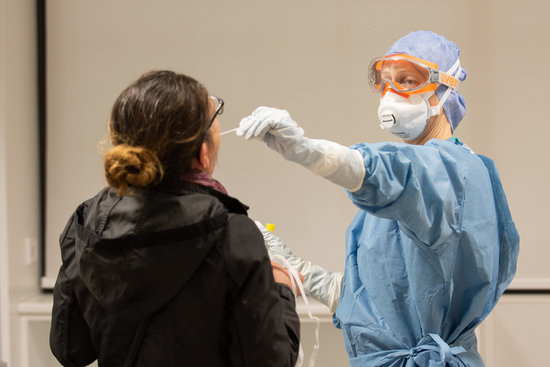Rate of growth of coronavirus cases and deaths slowing down in Catalonia and Spain
Effects of home confinement measures as part of the state of alarm are beginning to appear in statistics

Ever since the first confirmed case of covid-19 was found in Catalonia on February 25, the pandemic has become practically the sole matter at the forefront of everybody’s minds.
Extra government resources have been transferred to the health department, while citizens have not been able to leave their homes for anything but essential reasons, such as shopping for food or visiting health centers, since March 14 when the Spanish government formally declared a state of alarm due to the public health crisis.
Finally, 23 days of a state of alarm later, we are now seeing signs suggesting the coronavirus is slowing down.
As of Monday, April 6, Spain recorded 135,032 total confirmed cases of covid-19, and 13,055 deaths. The latest data from Catalonia is of the day before, Sunday, April 5, at which point there were 26,824 confirmed cases of the novel coronavirus, and 2,760 deaths.
Around the globe, Spain has now overtaken China and Italy in terms of coronavirus patients, and is now the country with the second most cases in the world, behind the United States.
However, despite how grim these figures read, the trend for deaths and cases is now beginning to move in the direction everybody wants to see, with authorities even announcing that the pandemic was beginning to stabilize in the country.
"Curve has stabilized"
March 30 was the worst day in Catalonia for both deaths and newly confirmed cases, with 262 and 2,616 respectively. For Spain, the following day saw the most amount of new infections confirmed, with 9,222, while more people died from the virus on April 2 than any other - 950.
Today, April 6, Spain recorded 637 further deaths, and 4,273 newly confirmed cases, significant reductions of the figures. Despite the recency of these worst-day statistics, the overall trend of newly confirmed cases have been decreasing in both Catalonia and Spain.
In Catalonia, the progression of newly confirmed cases from March 30 to April 6 is as follows: 2,616, 1,218, 1,813, 1,656, 1,274, 1,298, 792, 1,499. April 6 saw a spike in new cases, but it appears to be an anomaly in an otherwise downward moving trend.
Deaths per day in Catalonia for the same period: 262, 177, 244, 242, 173, 129, 123, 148.
In Spain, the progression of new cases since March 31 reads: 9,222, 7,719, 8,102, 7,472, 7,026, 6,023, 4,273.
Daily figures for deaths in Spain over that same period of time: 849, 864, 950, 932, 809, 674, 637.
On April 2, Spanish health minister Salvador Illa announced: "The figures demonstrate that the curve has stabilized, that we have achieved our first goal of reaching the peak, and that we are entering the slowdown phase."
Of course, we are still seeing many new cases confirmed and many deaths each day, but it is very welcome to see the rate of growth slowing down as it is.
The head of Spain’s health emergencies, Fernando Simón, believes that "the focus should not be the peak" of the curve, but rather the number of hospitalizations and people in intensive care.
All non-essential business activity remains in hibernation, while all non-essential journeys are still banned. Mobility has been severely reduced across the country, and everybody has been confined to their homes for over three weeks, a situation which will continue until at least April 25 as Spanish president Pedro Sánchez has already announced plans for a second extension to the state of alarm, as society attempts to collectively flatten the curve.
Meanwhile, Catalan vice president Pere Aragonès has argued that lockdown regulations will only be loosened once there is a sustained decrease in new coronavirus cases over a two-week period.
Good news stories have been few and far between lately, but the statistics are beginning to show that our efforts may soon be paying off. Catalonia and Spain will, unfortunately, continue to see many new deaths and confirmed cases for weeks to come, but we are now starting to see the pace of the coronavirus slowing down.